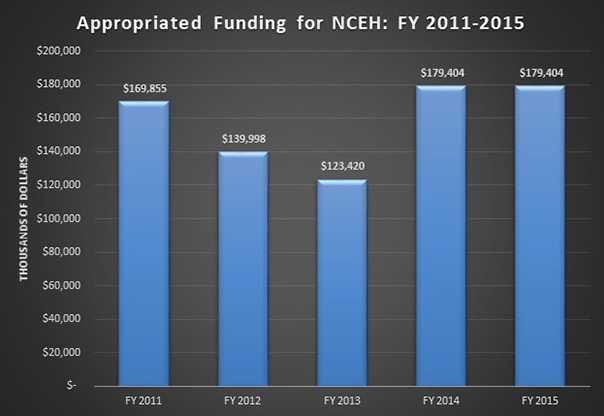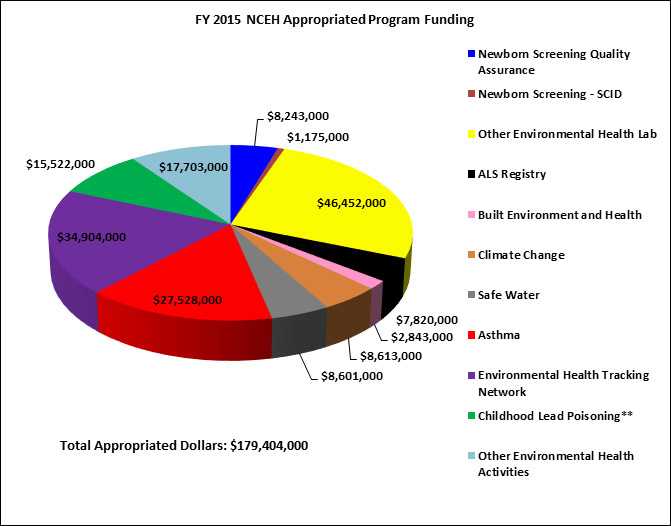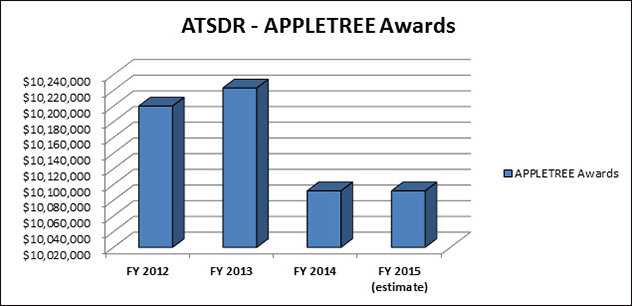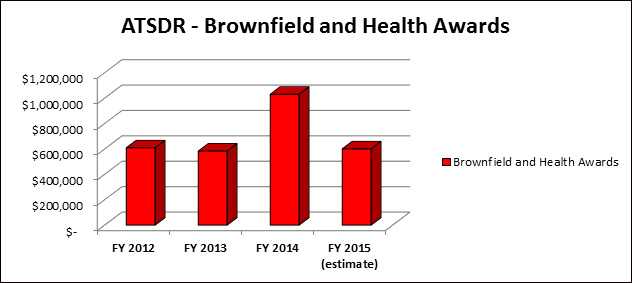NCEH/ATSDR Budget
Funding Process Overview
Congress funds the National Center for Environmental Health (NCEH) and the Agency for Toxic Substances and Disease Registry (ATSDR) through the annual appropriations process. The House and Senate Committees on Appropriations write spending bills and reports that specify funding levels for most federal agencies and discretionary programs. Each chamber of Congress must pass identical spending bills and send it to the president for signature. Assuming Congress passes a spending bill and the president approves it, funding is available for the fiscal year beginning on October 1.
In years when Congress is unable to pass a new spending bill, funding for NCEH and ATSDR may be extended via continuing resolutions that may last anywhere from a few days or up to the full fiscal year. These continuing resolutions often, but not always, fund agencies at the funding level from the previous fiscal year.
For more information about the federal funding process and budget, visit the Office of the Chief Financial Officer web page.
Appropriated Funding for NCEH/ATSDR: FY 2011-2015
Overall Appropriations
Over the past five fiscal years, Congress has funded NCEH and ATSDR at the following levels:
| Year | NCEH Budget | ATSDR Budget |
|---|---|---|
| FY 2011 | $169,855,000 | $76,638,000 |
| FY 2012 | $139,998,000 | $76,215,000 |
| FY 2013 | $123,420,000 | $76,215,000 |
| FY 2014 | $179,404,000 | $74,691,000 |
| FY 2015 | $179,404,000 | $74,691,000 |


(b) Specific Appropriations
In FY 2015, the appropriated funding for NCEH programs breaks down as follows:

**Includes $13,000,000 in funding from the PPHF.
ATSDR
ATSDR uses its appropriated funds to engage in activities that include health assessments and health studies, responding to environmental public health emergencies, supporting toxicological publications, providing specialized medical information, or conducting environmental surveillance.
However, ATSDR has several cooperative agreement programs for which funding was projected in our budget justification and for which Congress provided sufficient funding. These include:
- The ATSDR Partnership to Promote Local Efforts to Reduce Environmental Exposure (APPLETREE) funds health departments to investigate and respond to harmful exposures in our communities and teach the public about exposure protection. Information about our current partners can be found here.
- The Brownfield/Land Reuse Health Initiative provides support to communities in identifying health issues prior to redevelopment and monitoring progress on healthy redevelopment.
These charts show the funding for these cooperative agreements for FY 2011 to FY 2015:


NCEH/ATSDR Funded State and Local Programs: FY 2014
Notable Funding Level Changes: FY 2013-2014
Environmental Health Laboratory
In FY 2014, CDC received approximately $6 million in additional funding for the Environmental Health Laboratory. The laboratory’s efforts improve the detection, diagnosis, treatment and prevention of diseases resulting from harmful environmental exposures or that require advanced laboratory measurement to diagnose. The laboratory uses increased funding to standardize tests for important chronic disease biomarker measurements that need improvement in accuracy and precision. As Congress noted, biomarkers are a uniquely powerful tool to identify high-risk individuals, diagnose disease conditions promptly and accurately, and effectively track prevention and treatment efforts. The lab develops reference methods and materials to assure the quality of tests in clinical, research, and academic laboratories. Accurate and precise laboratory measurements help doctors better diagnose and determine risks for heart disease, improve the diagnosis and treatment of breast cancer, and reduce costs from repeated laboratory testing.
Additional funding also helps CDC maintain the world’s most advanced, state-of-the-art environmental public health laboratory. In FY 2014, the laboratory measured 345 priority chemicals and nutritional indicators in Americans, compared to 316 in FY 2013. The laboratory also participated in 100 studies of harmful chemical exposures, compared to 95 in FY 2013.
Environmental and Health Outcome Tracking Network
CDC received $11 million more in funding in FY 2014 compared to FY 2013 for the Tracking Network. The Tracking Network is a dynamic, web-based system that tracks and reports environmental hazards and related health problems. Environmental Health Tracking Network grants support the information technology to bring health and environmental data together, as well as the people who use data to identify, prioritize, and evaluate environmental health interventions. As the Senate has noted, the program has strengthened State and local agencies' ability to prevent and control diseases and health conditions that may be linked to environmental hazards. With CDC funding, state and local health departments develop their own tracking networks and contribute data to the national system. The additional funding allowed CDC to fund two new grantees and to increase the average grant award by nearly 46%. In FY 2014, grantees used Tracking Network data to undertake 36 public health actions that prevented or controlled potential adverse health effects from environmental exposures, compared to 32 in FY 2013.
CDC also used the increased funding to add several new content areas to the network, including pesticide poisoning exposure, 70 years of extreme heat projections, and park and school access. CDC also launched a new Health Impact Assessment tool.
Childhood Lead Poisoning Prevention
In FY 2014, the Childhood Lead Poisoning Prevention program received a $13.2 million increase in appropriated funds. The program provides national expertise, guidance, and surveillance of childhood lead poisoning in the United States. CDC remains a resource to federal, state, and local agencies on primary prevention and clinical interventions to prevent lead poisoning and other housing related diseases. With increased funding in FY 2014, CDC was able to restore funding to 35 state and local health departments for lead poisoning prevention programs. Based on CDC-funded data collection, health departments implement primary prevention interventions, including housing rehabilitation, housing and health code enforcement, early childhood education programs, and engagement with clinical care. CDC also used increased funding to train public health workers on reliable, low-cost methods for reducing lead and other risks through its National Healthy Homes Training Center and Network. In FY 2014, 20 states deployed the Healthy Homes and Lead Poisoning Surveillance System, compared to 18 states in FY 2013.
1 S. Rept. 113-71
2 Division G, Joint Explanatory Statement for the Consolidated and Further Continuing Appropriations Act, 2015.
- Page last reviewed: May 11, 2015
- Page last updated: May 11, 2015
- Content source:


 ShareCompartir
ShareCompartir